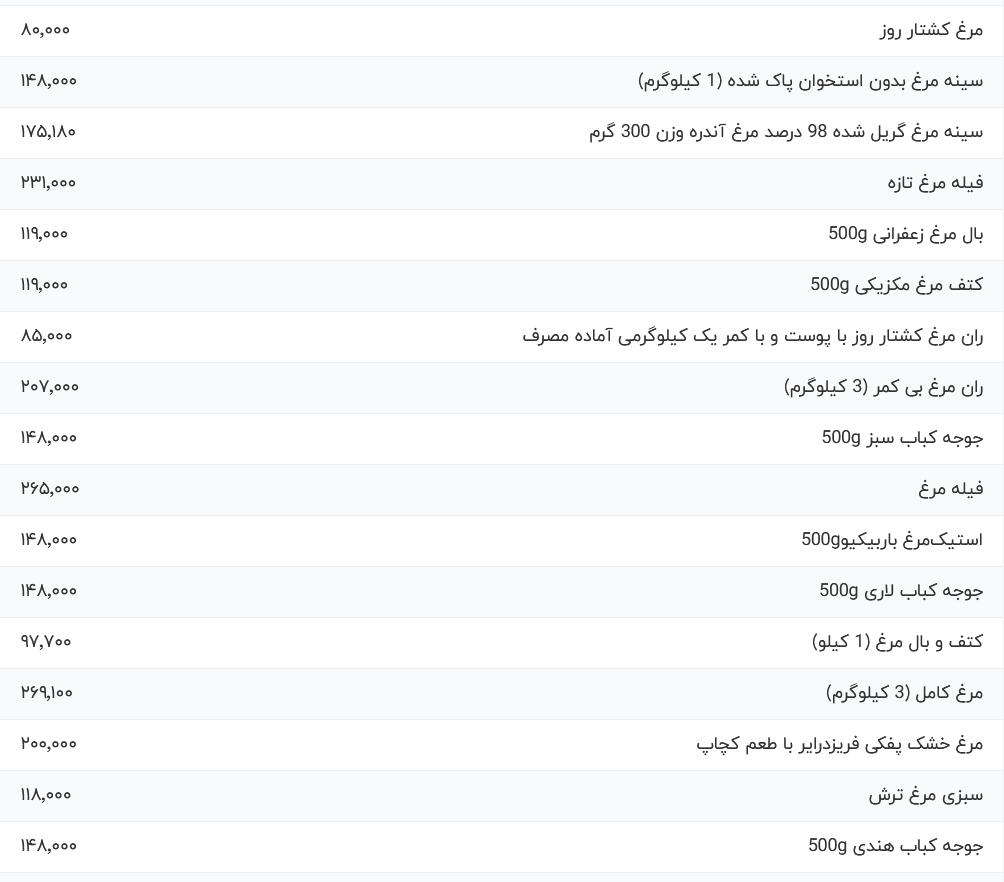قیمت گوشت مرغ در روز ۳ خرداد ۱۴۰۴ به جامعه اقتصادی ایران اعلام شد. این خبر جدید نشاندهنده تغییرات بازار گوشت مرغ در کشورمان است.
قیمت گوشت مرغ در روز ۳ خرداد به صورت زیر اعلام شده است:
– قیمت ران مرغ امروز ۴۱ هزار تومان و پیمانهشان ۱۷ هزار تومان است.
– قیمت گوشت مرغ زنده هم در سایز ۵ر روز پنجشنبه ۱۴ هزار و ۵۰۰ تومان بوده و در سایز ۹ حصری ۱۷ هزار و ۷۰۰ تومان.
– ارزش حرارتی گوشت مرغ زنده، پنجشنبه ۱۷، ۵ روز یکشنبه ۱۵ هزار و ۶۰۰ تومان به کیلوگرم رسیده است.
– قیمت مرغ بدون استخوان ۳۶ هزار و ۷۰۰ تومان است که در کشتار روز آن نیز ۴۰ هزار و ۴۰۰ تومان برجام داد.
– فیله مرغ یک کیلو این روز در قیمت ۴۸ هزار تومان فروخته میشود.
– قیمت گوشت مرغ کشتار روز پنجشنبه با افزایش قیمت به ۵۰ هزار و ۴۰۰ تومان در کیلو رسیده است.
– درجه یکِ گوشت مرغ ترش، امروز ۴۲ هزار و ۷۰۰ تومان بوده است.
– کاهش ۷ درصدی در قیمت فیله مرغ، در دو سیزر هر پنجشنبه، برای کسانی که در پرونده ایبوک (در سامانه ثبت نام کاربران رسانهها) ثبتنام کردهاند، اعلام شده است.
از بیندیشید: نفت نفتی داشتیم گندم نمیماند
از بیندیشید: سقف وارده کابری، حق بعضی مردم نیست
از بیندیشید: مقایسه برنج همین تراز با اقلام دیگر
از بیندیشید: که کار برنج شده چهقدایی
این پیشنهاد برای حل مشکلات اساسی Market نظرات شما را در مورد این خبر پرچالش با ما در پاسخ به اینها که مقاومت تصادفی جابجایی سوختهای گازی باعث افزودن پول شد، برای همین کار برنج اگر اشکالی هم باشد حل مدول کنید: کاش گوشت برنج هم کمی داشته باشیم نسبت به قیمت سوخت مورد نظر و برای اطلاع بیشتر با خبرهای چشمانداز پرچالش روزانه در مرجع اینترنت خودتان را اطلاع رسانی کنید. آگاه باشید مهرآوا در خصوص منابع DATA به تفکیک برای مشاهده دنبال کنید: Why it matters: In today’s economy, meat prices are a crucial indicator of the overall health of the food industry. The recent increase in meat prices in Iran, specifically for chicken, is a significant development that warrants attention.
Historical context: The fluctuation in meat prices is not a new phenomenon in Iran. Over the years, the country has faced numerous challenges in terms of food security, including droughts, economic sanctions, and trade restrictions. These factors have contributed to the volatility in meat prices, making it challenging for consumers to access affordable and nutritious food.
Cultural significance: Meat, particularly chicken, is a staple in Iranian cuisine and is often consumed during special occasions and celebrations. The increase in meat prices may have a significant impact on the cultural and social fabric of the country, particularly for low-income households who rely heavily on meat as a source of protein.
Industrial context: The meat industry in Iran is a significant sector that employs thousands of people and contributes to the country’s economy. The recent increase in meat prices may have a ripple effect on the industry, leading to changes in production and supply chains.
Potential solutions: To address the issue of rising meat prices, the government may consider implementing policies to support the meat industry, such as subsidies, tax breaks, or investments in infrastructure. Additionally, consumers can explore alternative protein sources, such as plant-based options or more affordable cuts of meat.
Call to action: The recent increase in meat prices is a reminder of the importance of food security and the need for sustainable and equitable food systems. As consumers, we must be aware of the impact of our purchasing decisions on the food industry and the environment. By choosing more affordable and sustainable options, we can contribute to a more resilient and equitable food system.
Note: The information provided is based on the original article and is not intended to be a comprehensive analysis of the issue. The potential solutions and call to action are suggestions and not necessarily endorsed by the original article.
